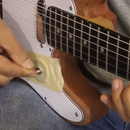Introduction: Laser Cutter Setup [60 Watt, CO2]
Laser cutting and engraving machines are incredible tools, however, actually getting one set up and running in your shop or garage can be daunting. Here I'll outline some of the steps I went through to unbox my "Red and Black" 60W laser cutter.
Step 1: Unboxing
First you'll need to actually get the unit out of the crate. I paid for lift gate service as I don't have a way to actually get a large package in my garage. Be sure you have space prepared before it shows up!
From there, you'll need to open the package with a hammer, chisel, etc, and then get it onto the ground. Best to get someone(s) to help, but as shown in the video, I did the majority of it myself.
Step 2: Fume Extraction
Your laser will emit smoke, so it's important to get it out of there somehow. My unit came with a blower, as well as a big blue hose to suck everything out. As I wasn't excited about pumping unfiltered smoke into the neighborhood, I purchased an 80W fume extractor found here.
While it does its job, I can still smell some smoke in the garage after cutting, and am looking to upgrade things. A prototype "dual fan" setup is seen in the image above, but that ended up not working out. Once my new setup is done (are these things ever really done though?) I'll put an update on my YouTube channel. Various 3D-printed adapters and such for extraction are found here on GitHub.
Step 3: Power and Storage
If you've spec'd things correctly, you simply plug the laser into the wall. However, you'll need power for the fume extraction fan and chiller, and the "universal" outlets on back of the laser are apparently not to be trusted. Get a power strip and plug everything in.
For that matter, you'll want a rack on which to place your different accessories.
I used this one from Amazon, which seems like a good option. Actually, I have three of those racks, so would recommend highly.
Step 4: Safety
I go over this in the video a bit more, but I'd recommend the following:
- Laser safety glasses - I used glasses from Laser Safety Industries. Make sure they're rated for the correct wavelength of your laser.
- Fire extinguisher - good idea generally, even better with something that works by literally burning parts
- Door interlock - basically turns the laser process off when you open the door. As explained in the video, I wouldn't necessarily trust this as a primary safety device, but a good idea nonetheless.
Step 5: Ammeter, Network, and Accessories
You can add a 30mA ammeter (this one, Amazon) to the laser tube (on the negative side) to monitor current output. The potential down side is that you're dealing with a massive amount of voltage, so there is some potential safety concern if the circuit breaks at the wrong time. Use your own judgement here. I generally don't run my laser much over 20mA, and the controller can push it well past that point.
Step 6: Ethernet!
Had a physical Ethernet connection run to the garage. Optional, but makes it very easy to log on via software like LightBurn–a great piece of software, highly recommended. Added a 5-port switch, which allowed me to connect my 3D-printer's OctoPi setup as well, which seems to enhance the performance.
Step 7: Enjoy!
Once you have things set up, you can start to learn more about "lasering."
While actually cutting things properly is a massive subject, it's amazing to be able to simply push a button and have it do you bidding. Besides possibly a few magnets for light items, complicated workholding like a CNC router isn't required, and it's much faster than a 3D printer. Like anything else, this tool has its limits, but can be a great addition to your shop!
*Note Amazon links found here are affiliate













